124 books about Motion picture industry and 6
start with N
124 books about Motion picture industry and 6
124 books about Motion picture industry
6 start with N start with N
6 start with N start with N
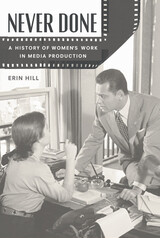
Never Done
A History of Women’s Work in Media Production
Hill, Erin
Rutgers University Press, 2016
Winner of the 2018 Best First Book Award from the Society for Cinema and Media Studies (SCMS)
Histories of women in Hollywood usually recount the contributions of female directors, screenwriters, designers, actresses, and other creative personnel whose names loom large in the credits. Yet, from its inception, the American film industry relied on the labor of thousands more women, workers whose vital contributions often went unrecognized.
Histories of women in Hollywood usually recount the contributions of female directors, screenwriters, designers, actresses, and other creative personnel whose names loom large in the credits. Yet, from its inception, the American film industry relied on the labor of thousands more women, workers whose vital contributions often went unrecognized.
Never Done introduces generations of women who worked behind the scenes in the film industry—from the employees’ wives who hand-colored the Edison Company’s films frame-by-frame, to the female immigrants who toiled in MGM’s backrooms to produce beautifully beaded and embroidered costumes. Challenging the dismissive characterization of these women as merely menial workers, media historian Erin Hill shows how their labor was essential to the industry and required considerable technical and interpersonal skills. Sketching a history of how Hollywood came to define certain occupations as lower-paid “women’s work,” or “feminized labor,” Hill also reveals how enterprising women eventually gained a foothold in more prestigious divisions like casting and publicity.
Poring through rare archives and integrating the firsthand accounts of women employed in the film industry, the book gives a voice to women whose work was indispensable yet largely invisible. As it traces this long history of women in Hollywood, Never Done reveals the persistence of sexist assumptions that, even today, leave women in the media industry underpraised and underpaid.
For more information: http://erinhill.squarespace.com
For more information: http://erinhill.squarespace.com
[more]

The New American Cinema
Jon Lewis, ed.
Duke University Press, 1998
This collection of essays provides the first comprehensive survey of Hollywood and independent films from the mid-sixties to the present. Deliberately eclectic and panoramic, The New American Cinema brings together thirteen leading film scholars who present a range of theoretical, critical, and historical perspectives on this rich and pivotal era in American cinema.
The essays are divided into three sections: "Movies and Money," "Cinema and Culture," and "Independents and Independence." The first section focuses on the economics of the industry and analyzes the connection between the film business and the finished product. Topics include a look at the economic conditions that made the seventies’ auteur renaissance possible, the distribution of studio and independent films, and the recent spate of mergers and acquisitions that have come to characterize the new Hollywood. The second part of The New American Cinema deals with the political and cultural significance of war and Vietnam films (Platoon, Apocalypse Now, Born on the Fourth of July); "male rampage" films (Rambo, Lethal Weapon, Die Hard); women’s psychothrillers (The Silence of the Lambs); special effects pictures (2001: A Space Odyssey, Star Wars); and historical re-presentations (Oliver Stone’s JFK). The final section casts a keen eye on films produced and exhibited outside the commercial mainstream, examining the financial realities of "indie" films; the influence of independent filmmaker John Cassavetes on Coppola, Altman, and Scorsese; the stereotyping of African Americans in mainstream cinema; and the films of independent women filmmakers.
The essays are divided into three sections: "Movies and Money," "Cinema and Culture," and "Independents and Independence." The first section focuses on the economics of the industry and analyzes the connection between the film business and the finished product. Topics include a look at the economic conditions that made the seventies’ auteur renaissance possible, the distribution of studio and independent films, and the recent spate of mergers and acquisitions that have come to characterize the new Hollywood. The second part of The New American Cinema deals with the political and cultural significance of war and Vietnam films (Platoon, Apocalypse Now, Born on the Fourth of July); "male rampage" films (Rambo, Lethal Weapon, Die Hard); women’s psychothrillers (The Silence of the Lambs); special effects pictures (2001: A Space Odyssey, Star Wars); and historical re-presentations (Oliver Stone’s JFK). The final section casts a keen eye on films produced and exhibited outside the commercial mainstream, examining the financial realities of "indie" films; the influence of independent filmmaker John Cassavetes on Coppola, Altman, and Scorsese; the stereotyping of African Americans in mainstream cinema; and the films of independent women filmmakers.
[more]
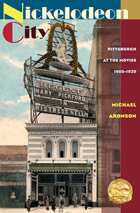
Nickelodeon City
Pittsburgh at the Movies, 1905-1929
Michael Aronson
University of Pittsburgh Press, 2010
From the 1905 opening of the wildly popular, eponymous Nickelodeon in the city's downtown to the subsequent outgrowth of nickel theaters in nearly all of its neighborhoods, Pittsburgh proved to be perfect for the movies. Its urban industrial environment was a melting pot of ethnic, economic, and cultural forces—a “wellspring” for the development of movie culture—and nickelodeons offered citizens an inexpensive respite and handy escape from the harsh realities of the industrial world.
Nickelodeon City provides a detailed view inside the city's early film trade, with insights into the politics and business dealings of the burgeoning industry. Drawing from the pages of the Pittsburgh Moving Picture Bulletin, the first known regional trade journal for the movie business, Michael Aronson profiles the major promoters in Pittsburgh, as well as many lesser-known ordinary theater owners, suppliers, and patrons. He examines early film promotion, distribution, and exhibition, and reveals the earliest forms of state censorship and the ensuing political lobbying and manipulation attempted by members of the movie trade. Aronson also explores the emergence of local exhibitor-based cinema, in which the exhibitor assumed control of the content and production of film, blurring the lines between production, consumption, and local and mass media.
Nickelodeon City offers a fascinating and intimate view of a city and the socioeconomic factors that allowed an infant film industry to blossom, as well as the unique cultural fabric and neighborhood ties that kept nickelodeons prospering even after Hollywood took the industry by storm.
Nickelodeon City provides a detailed view inside the city's early film trade, with insights into the politics and business dealings of the burgeoning industry. Drawing from the pages of the Pittsburgh Moving Picture Bulletin, the first known regional trade journal for the movie business, Michael Aronson profiles the major promoters in Pittsburgh, as well as many lesser-known ordinary theater owners, suppliers, and patrons. He examines early film promotion, distribution, and exhibition, and reveals the earliest forms of state censorship and the ensuing political lobbying and manipulation attempted by members of the movie trade. Aronson also explores the emergence of local exhibitor-based cinema, in which the exhibitor assumed control of the content and production of film, blurring the lines between production, consumption, and local and mass media.
Nickelodeon City offers a fascinating and intimate view of a city and the socioeconomic factors that allowed an infant film industry to blossom, as well as the unique cultural fabric and neighborhood ties that kept nickelodeons prospering even after Hollywood took the industry by storm.
[more]
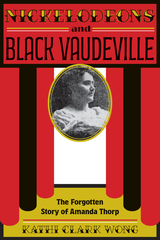
Nickelodeons and Black Vaudeville
The Forgotten Story of Amanda Thorp
Kathi Clark Wong
University of Tennessee Press, 2023
In an era of online streaming, it may be difficult to recognize the importance of a woman who in 1908 established the first silent movie theater in Richmond, Virginia: the Dixie nickelodeon. But Amanda Thorp, an independent, self-made woman, was on the ground floor of a popular culture that would grow to be enormously influential in our modern era. In Nickelodeons and Black Vaudeville: The Forgotten Story of Amanda Thorp, Kathi Clark Wong’s extensive archival research uncovers Thorp’s impressive contributions not only to moviegoing and its growth in America, but also perhaps even more surprisingly, Thorp’s support of early Black vaudeville in the Jim Crow South.
Movie theater entrepreneurs like Thorp, who got her start at her Wonderland Theater in Bucyrus, Ohio, helped create our culture’s insatiable appetite for film. But it was after she established the Dixie in Richmond, that Thorp—a White woman—also saw a market for providing Black-centric entertainment. She converted the Dixie to all-Black patronage and began to bring in scores of Black vaudeville acts. Later, she built the Hippodrome Theater, in the heart of Richmond’s now-historic Jackson Ward, expressly for Black entertainment. Though she eventually left the field of Black entertainment behind, Thorp developed other movie venues in Richmond that brought in tens of thousands of (White) moviegoers over the years and which were widely admired for their elaborate trappings.
Thanks to Wong’s research, contemporary readers can now benefit from the story of Amanda Thorp, a woman who amidst severe gender role constraints not only claimed social capacity on the crest of a rapidly growing industry but also, almost inadvertently, contributed to the success of early Black vaudeville, a subject which thus far has not received the scholarly attention it deserves.
Movie theater entrepreneurs like Thorp, who got her start at her Wonderland Theater in Bucyrus, Ohio, helped create our culture’s insatiable appetite for film. But it was after she established the Dixie in Richmond, that Thorp—a White woman—also saw a market for providing Black-centric entertainment. She converted the Dixie to all-Black patronage and began to bring in scores of Black vaudeville acts. Later, she built the Hippodrome Theater, in the heart of Richmond’s now-historic Jackson Ward, expressly for Black entertainment. Though she eventually left the field of Black entertainment behind, Thorp developed other movie venues in Richmond that brought in tens of thousands of (White) moviegoers over the years and which were widely admired for their elaborate trappings.
Thanks to Wong’s research, contemporary readers can now benefit from the story of Amanda Thorp, a woman who amidst severe gender role constraints not only claimed social capacity on the crest of a rapidly growing industry but also, almost inadvertently, contributed to the success of early Black vaudeville, a subject which thus far has not received the scholarly attention it deserves.
[more]
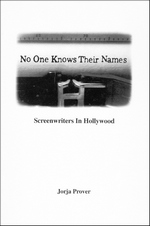
No One Knows Their Names
Screenwriters in Hollywood
Jorja Prover
University of Wisconsin Press, 1994
This is the first study of Hollywood by an anthropologist. Jorja Prover examines how different groups of individuals, separated from one another superficially by ethnicity, race, and sex, function as writers in Hollywood. She describes the white “majority” Hollywood writers and explores their concerns and creative processes, and then discusses other writers who, until recently, have been virtually invisible in the entertainment industry—women, the physically challenged, gays, African Americans, Latinos, and Asians. In detailing their efforts at gaining professional acceptance, these writers introduce new, previously unmentioned issues involving access, advancement, talent, sexual harassment, and discrimination.
[more]
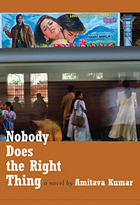
Nobody Does the Right Thing
A Novel
Amitava Kumar
Duke University Press, 2010
A young poet is killed by her lover, a politician, in the eastern Indian state of Bihar. Soon afterward, across India in Bombay, an idealistic journalist is hired by a movie director to write a Bollywood screenplay about the murdered poet. Research for the script takes the writer, Binod, back to Bihar, where he and his cousin Rabinder were raised. While the high-minded Binod struggles to turn the poet’s murder into a steamy tale about small towns, desire, and intrigue, Rabinder sits in a Bihari jail cell, having been arrested for distributing pornography through a cybercafé. Rabinder dreams of a career in Bollywood filmmaking, and, unlike his cousin, he is not burdened by ethical scruples. Nobody Does the Right Thing is the story of these two cousins and the ways that their lives unexpectedly intertwine. Set in the rural villages of Bihar and the metropolises of Bombay and Delhi, the novel is packed with telling details and anecdotes about life in contemporary India. At the same time, it is a fictional investigation into how narratives circulate and vie for supremacy through gossip, cinema, popular fiction, sensational journalism, and the global media.
[more]
READERS
Browse our collection.
PUBLISHERS
See BiblioVault's publisher services.
STUDENT SERVICES
Files for college accessibility offices.
UChicago Accessibility Resources
home | accessibility | search | about | contact us
BiblioVault ® 2001 - 2024
The University of Chicago Press









